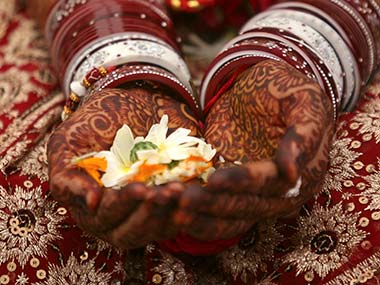If you are wondering why dowry is dying a slow death despite the serious shortage of female population in India, the answer may lie partially in demographics. The 2011 census tells us that there are only 940 women for every 1,000 men. In simple economics, scarcity should mean better treatment of women. Men should be paying bride price, not women dowry. However, a closer look at the numbers of men and women in the marriageable age shows that the skew is in the opposite direction. There are more women of marriageable age (considering the Indian context) than men. For our purposes, we take the marriageable age of men to be 21-38, and for women 18-35 – an 18-year marriage window for both sexes, with an age gap of three between them. It needs to be remembered that the law in India puts different marriageable ages for boys and girls hence the different number sets for the two groups. ( 18 for girls while 21 for boys) [caption id=“attachment_1114615” align=“alignleft” width=“380”] Representational Image. Reuters[/caption] Save Indian Family, a
site devoted to fighting misandry (the opposite of misogyny) and discrimination against men,
brought this gap to our notice. On checking some of the original numbers at the Census of India’s website (see the full data
here), we found that some Save Indian Family data to be exaggerated, but there is no doubt that there is an excess of women over men in these age groups. This is how the numbers stack up. There is a gap of nearly 8.5 million men all-India – which means women outnumber men in the marriageable age group by this figure (see table below).
The gap is larger in rural areas – possibly due to migration of men to urban areas. In rural areas, there are 7.5 million more women of marriageable age than men. Of course, the ratios will change if we change ages for marriage, but the broad skew currently is difficult to miss. However, there is another side to this coin. Thanks to sex-determination tests and other efforts to produce boys rather than girls across communities, the sex ratio is 914 for children in the 0-6 age group, according to Census 2011. As this group of kids grows to marriageable age in the next two decades, the skew will reverse. There could be more men than women in the marriageable age.


)

)
)
)
)
)
)
)
)



